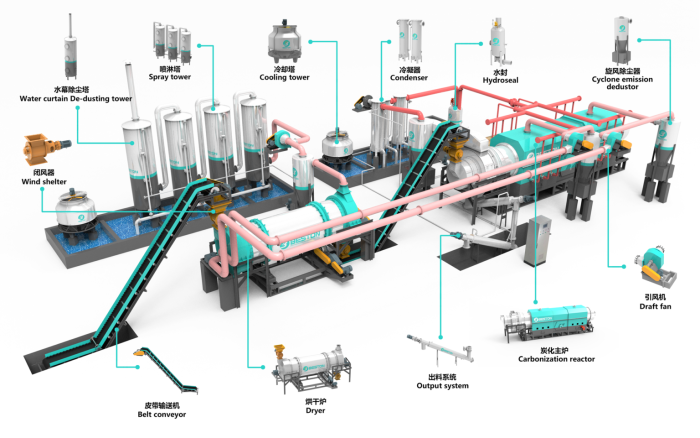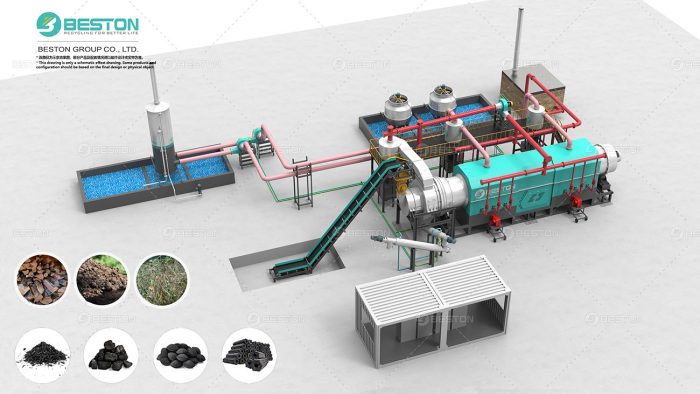In the realm of sustainable resource management, the carbonization machine emerges as a pivotal tool, offering a promising solution to organic waste management while concurrently addressing the escalating concerns of environmental degradation. This feasibility report delves into the efficacy and viability of the Beston Carbonation Equipment Project, meticulously dissecting its technical intricacies, economic prospects, and environmental implications.

Introduction
The contemporary landscape underscores an urgent need for innovative waste management solutions, particularly in the domain of organic waste. The Beston carbonation equipment project epitomizes a pioneering endeavor aimed at revolutionizing the conventional paradigms of waste disposal. Harnessing advanced carbonization technology, this project endeavors to convert organic waste into valuable resources, thereby mitigating environmental hazards and fostering sustainable development.
Technical Analysis
At the crux of the Beston Carbonation Equipment Project lies a sophisticated biochar machine, meticulously engineered to facilitate the thermal decomposition of organic matter under controlled conditions. Utilizing pyrolysis, this apparatus catalyzes the conversion of biomass into biochar, syngas, and bio-oil. The inherent efficiency and scalability of this technology render it well-suited for diverse applications, ranging from agricultural residues to municipal solid waste.
The modular design of the carbonization machine underscores its adaptability to varying feedstock compositions and processing capacities. Equipped with state-of-the-art control systems, it ensures precise regulation of temperature, pressure, and residence time, thereby optimizing product quality and process efficiency. Furthermore, the integration of emission control mechanisms mitigates environmental pollutants, aligning with stringent regulatory standards.

Economic Assessment
From an economic standpoint, the charcoal making machine project exhibits commendable prospects for profitability and financial viability. The valorization of organic waste into high-value products, including biochar and syngas, engenders revenue streams while concurrently reducing waste disposal costs. The diversified market potential, spanning agriculture, energy, and environmental sectors, augments the project’s resilience to market fluctuations.
The capital investment required for establishing the carbonization infrastructure constitutes a substantial but justifiable expenditure, considering the long-term returns and societal benefits. Moreover, the potential for carbon credit monetization and governmental incentives further enhances the project’s attractiveness from an investment perspective. Through prudent financial planning and strategic partnerships, the project can realize its economic objectives while fostering socio-economic development.
Environmental Impact Assessment
Central to the ethos of the Beston Carbonation Equipment Project is its commitment to environmental stewardship and sustainability. By diverting organic waste from landfills and incineration, the biomass pyrolysis process mitigates greenhouse gas emissions, thereby attenuating the adverse effects of climate change. The production of biochar, renowned for its carbon sequestration properties, contributes to soil health improvement and ecosystem restoration.
Furthermore, the utilization of syngas as a renewable energy source displaces fossil fuel consumption, thereby reducing dependency on non-renewable resources and curbing air pollution. The net environmental benefit, encompassing carbon dioxide mitigation, soil enrichment, and energy conservation, underscores the project’s role in fostering ecological resilience and combating environmental degradation.

Conclusion
In conclusion, the Beston Carbonation Equipment Project emerges as a paradigmatic exemplar of sustainable waste management and resource utilization. Through the integration of advanced carbonization technology, the project not only addresses the pressing challenges of organic waste disposal but also catalyzes economic prosperity and environmental preservation. As society grapples with the imperatives of sustainable development, initiatives such as this epitomize a beacon of hope, heralding a future where innovation harmonizes with environmental stewardship.